The Desktop Kabini Review Part 1: AMD Athlon 5350 (AM1) Tested
by Ian Cutress on April 9, 2014 8:00 AM ESTIGP Comparison, Synthetics
AMD’s graphics stack from top to bottom is all based on the Graphics Core Next architecture. This is an update from earlier VLIW implementations, offering for scalability from low power all the way up to high performance. At the heart of an AMD graphics system is the compute unit comprising of 64 GPU cores. Each compute unit can act independently, ensuring that multiple tasks can complete as quickly as possible due to multiple kernel dispatch across the entire core. In the Kaveri APU launch we were dealing with APUs that contained 6 or 8 compute units for 384/512 cores. With this level of performance, gaming at 1080p30 was possible on most titles depending on how the quality settings were configured. For Kabini, the entire range is given two compute units, with individual processors differing in clock speed.
With two compute units, we are not expecting much from the gaming aspect of these APUs in terms of ‘the latest’ titles. Our benchmarks in the next few pages show that even F1 2013 at 1280x1024 on low settings, unless the engine powering the game is basic, 25 FPS minimum is a hopeful target. This lack of horsepower may limit these APUs to Flash based titles, perhaps even some of the more reasonable Unity games. In AMD’s slide deck they quote games such as Minecraft, Lego Marvel Superheroes and Bastion as the sort of titles that a Kabini player should aim for.
There is some confusion regarding the naming convention of these integrated graphics solutions. Soldered on Kaveri parts designed for all-in-ones, such as the A6-5200, use the HD8000 naming scheme, such as the HD8400. The Athlon 5350 is analogous in design to the A6-5200 except for a 50 MHz speed bump and the name of the IGP – here this is designated as the R3 series. This is despite retailers who are currently selling this APUs and labeling them with the HD8000 designations.
Like Kaveri, the integrated graphics solution in Kabini features an updated Video Codec Engine and Unified Video Decoder giving hardware support for H.264.
AMD is also promoting their Picture Perfect solution, using additional post processing tools to increase video quality on the fly:
Also rather interestingly AMD is claiming an enhanced decoder for JPEG files. Given that one of the primary uses for a Kabini system might be for web access where JPEGs are standard, AMD has been promoting up to a 2x performance increase over a J2900 system:
AMD’s secret sauce, according to their slides, appears to be heterogeneous computing. This would be the ideal usage scenario for computing going forward.
GPU Synthetics
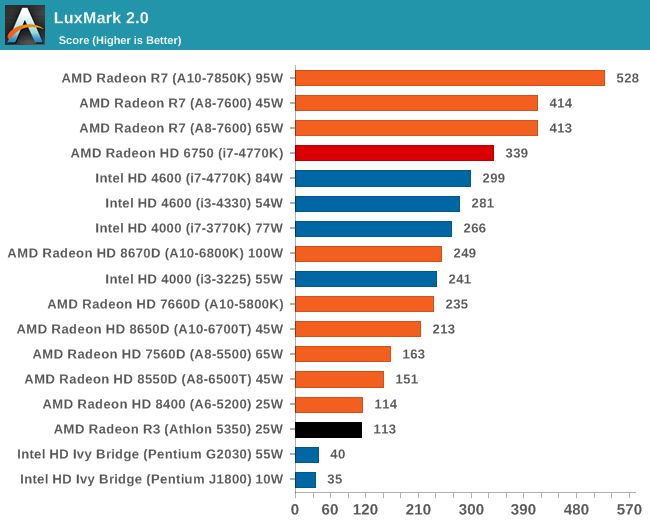




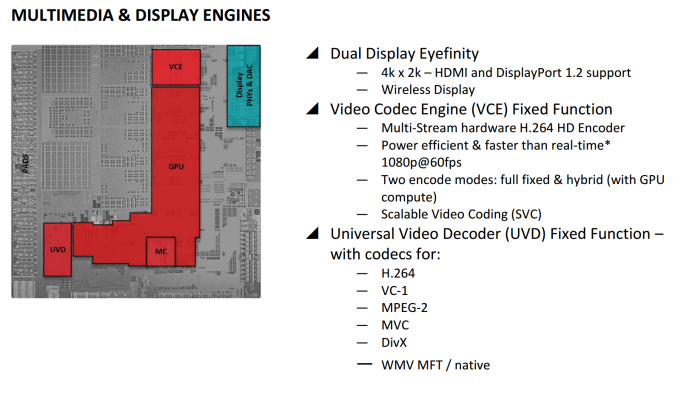
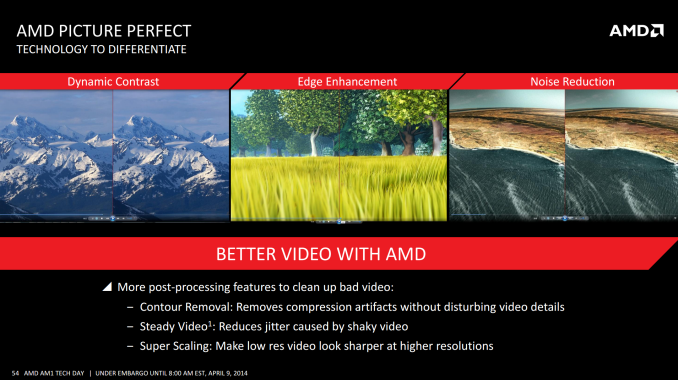
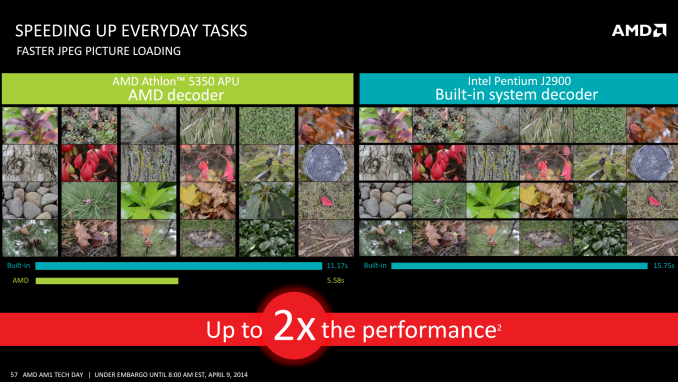
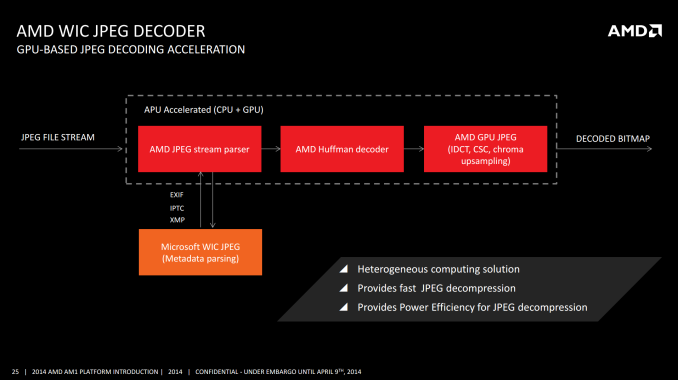








126 Comments
View All Comments
meacupla - Wednesday, April 9, 2014 - link
oh, god... semiporn is back...ViRGE - Wednesday, April 9, 2014 - link
There's a Duron joke in here somewhere...Death666Angel - Wednesday, April 9, 2014 - link
The good old days for AMD. That's when I got into PC stuff. Good times.nathanddrews - Wednesday, April 9, 2014 - link
Please tell me you are going to pair Kabini with 295x2. LOLscottjames_12 - Wednesday, April 9, 2014 - link
That WOULD be interesting! See how starved the monster GPU gets with an anemic CPU..nathanddrews - Wednesday, April 9, 2014 - link
I know that people are always trying to pair appropriate CPUs and GPUs together to avoid bottlenecks, but the honest truth is that a lot of people just leapfrog their builds every few years alternating between CPU and GPU upgrades. I don't know many people that buy/build a completely new system every 2 or 5 years. I know it happens plenty, but I know a lot of people running Conroe-era CPUs with modern GPUs. Up until a year ago, I was running an old GTX 470 on my 3570K. If money were no object, I would constantly be upgrading, but for now I wait until I absolutely need to.I'm probably just weird, but I spent a couple *hours* over the weekend watching YouTube videos of old PCI or AGP-based Pentium and Athlon systems playing modern games and modern OSs. Some are terrible while others are actually playable. Pushing old or slow hardware beyond the reasonable limits to see just what you can get away with is a fun pastime of mine.
NeatOman - Wednesday, April 9, 2014 - link
I always tell people to go a little overkill on the CPU in case later on they upgrade the GPU.. mostly because they wont be gaming on it most the time and i think its money better spent and later it won't give you much of a CPU bottleneck. Also because if you got a i7 from 6 years ago (yeah, they came out in 2008).. it would only be about 15%-20% slower. But a GPU that was $300 6 years ago lol, yeah right... a HD 3850 from around 6 years ago is about 1/3 the speed of a HD 7850 and twice the price. So over time a CPU holds it value and GPU can drop from year to year by up to half (for the high end models).I've found that spending more then $250 ($200 being the sweet spot) is a point of diminishing returns, and same goes for CPU's.
fokka - Wednesday, April 9, 2014 - link
i'd still go with a fast i5 instead of i7, except i've really got money to burn. i5 is where you get the best bang for your buck at intel, with a level of performance sufficient for the following years. paying 50% more for 10-20% increased performance doesn't seem very effective to me. this might have been a bit different with the first core-i CPUs.you're right about the GPUs though.
jonathanharrison - Thursday, April 10, 2014 - link
I wish they made more P-series chips, like the i5-3350P, that has the graphics core disabled, for gamers who are just going to get a discrete card(s) anyway. An i3-4370P (you could speed bump the core to 3.8, maybe 4.0GHz since you would be disabling the graphics core) would be nice. So would an i5-3570PK :) But that would just be tantamount to intel admitting failure at delivering 3D performance. Oh, this is an AMD article? Heh, I almost forgot with everyone talking about intel.tecknurd - Wednesday, April 9, 2014 - link
You may think that going "a little overkill on the CPU" may be a good suggestion, but it is not. I found over the years that it is better to spend on the storage system and memory. Back in 2012, I went with a i3-3225. I could go with an i5-3570 processor. That i5 processor will be a little overkill of what I do. The cost of that i5 processor just gives me a lot of grunt that I will rarely will use. That i5 processor will cut in my budget, so I can not go with a good storage system and/or go with a decent size of memory. If I add a graphics card, the med-end graphics models would not be bottleneck by my processor. If I go with a high-end graphics models, then yes the processor that I picked will bottleneck the high-end graphics card.A CPU only holds value if it is overclockable and the motherboard supports overclocking the processor. The storage system holds more value than any hardware in your computer because the reason why people went from hard drives to solid-state drives. A graphics card has no value since the technology of graphics changes dramatically. Also high quality or details of graphics during game play does not matter.